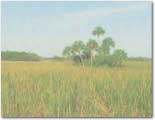Ecosystem History of the Southwest Coast-Shark River Slough Outflow Area
|
Project Investigator:
G. Lynn Wingard
Project Personnel: Thomas M. Cronin, Charles W. Holmes, Debra A. Willard, William H. Orem, James Murray, Carlos Budet, Marci Marot, Ruth Ortiz, Margo Corum, Thomas Sheehan, Harry E. Lerch Project Start Date: 2003 End Date: 2008 Recent Funding: (FY07) USGS GE PES, (FY06) USGS GE PES, (FY05) USGS GE PES |
| Summary |
| The objectives of this project are to document impacts of changes in salinity, water quality, coastal plant and animal communities and other critical ecosystem parameters on a subdecadal-centennial scale in the southwest coastal region, and to correlate these changes with natural events and resource management practices. |
One of the primary goals of the Central Everglades Restoration Plan (CERP) is to restore the natural flow of water through the terrestrial Everglades and into the coastal zones. Historically, Shark River Slough, which flows through the central portion of the Everglades southwestward, was the primary flow path through the Everglades Ecosystem. However, this flow has been dramatically reduced over the last century as construction of canals, water conservation areas and the Tamiami Trail either retained or diverted flow from Shark River Slough. The reduction in flow and changes in water quality through Shark River have had a profound effect on the freshwater marshes and the associated coastal ecosystems. Additionally, the flow reduction may have shifted the balance of fresh to salt-water inflow along coastal zones, resulting in an acceleration of the rate of inland migration of mangroves into the freshwater marshes. For successful restoration to occur, it is critical to understand how CERP and the natural patterns of freshwater flow, precipitation, and sea level rise will affect the future maintenance of the mangrove-freshwater marsh ecotone and the coastal environment. This project will provide 1) baseline data for restoration managers and hydrologic modelers on the amount and sources of freshwater influx into the southwest coastal zone and the quality of the water, 2) the relative position of the coastal marsh-mangrove ecotone at different periods in the past, and 3) data to test probabilities of system response to restoration changes.
Work Plans
Project Summaries
Data
- Ecosystem History of South Florida Estuaries Data (from the data exchange pages)
Metadata
- Ecosystem History of the Southwest Coast-Shark River Slough Outflow Area (project metadata)
- Ecosystem History of South Florida Estuaries Data (data set metadata)
Publications
Abstracts
- Assessment Of Historical Ecological Changes Using A Molecular Approach (from the GEER Conference, June 2006)
Open File Reports
- Descriptions and Preliminary Report on Sediment Cores from the Southwest Coastal Area, Everglades National Park, Florida (USGS OFR 2005-1360)
- Descriptions and Preliminary Report on Sediment Cores from the Southwest Coastal Area, Part II: Collected July 2005, Everglades National Park, Florida (USGS OFR 2006-1271)

